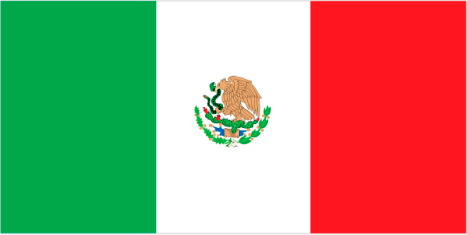To help inspire or plan your trip to Mexico, some of its major attractions
for travellers are shown below, including some of the best natural, historical, cultural and adventure sites in the country.
These include all of UNESCO World Heritage Sites for Mexico which represent the best
of the world's cultural and natural heritage.
Click on the icons below to focus on specific types of features
(click again to return to all).
|
|
|
|
|
|
|
|
|
|
|
|
 |
|---|---|---|---|---|---|---|---|---|---|---|---|
| Natural | History | Wildlife | Trekking | Cities | Religious Monument | Boat Journey | Rail Journey | Diving | Cultural | Adrenaline | UNESCO WHS |
Central Mexico - Cultural attractions
| Mexico City | |
|---|---|
Mexico City, known locally as Distrito Federal of DF, is the country's capital and one of the world's largest and most densely populated cities. Home to over 18 million people, it is a bustling and chaotic city that mixes ancient Aztec ruins, colonial architecture and a vibrant and modern culture. The city was built by the Spanish on the foundations of the great Aztec capital Tenochtitlan. The ruins of the Aztec Templo Mayor, dating from the 14th and 15th centuries, can be seen today near the city's main square, the Zocalo. The vast Zocalo is also home to the city's magnificent cathedral and the 16th century Palacio National, with its stunning Baroque architecture and murals of Diego Rivera. The National Museum of Anthropology is another of the city's must-sees with its excellent collection of exhibits of Mexico's pre-Hispanic cultures which include Olmec carvings, Toltec heads and an impressive ethnology display. The city also offers opportunities to experience Mexico's diverse sporting culture, which includes bullfighting, football at one of the city's many stadia and the unique Mexican wrestling spectacle of Lucha Libre. UNESCO World Heritage Site: Historic Centre of Mexico City and Xochimilco | |
| Central University City Campus of the Universidad Nacional Autónoma de México (UNAM) | |
|---|---|
The buildings of the Central University City Campus of the Universidad Nacional Autónoma de México (UNAM) were built from 1949 to 1952 by more than 60 architects, engineers and artists which together constitute one of the most significant modernist ensembles in Latin America. The most iconic building on campus is the Biblioteca Central which is covered with the tiled murals of Juan O'Gorman representing modern and historic Mexico. UNESCO World Heritage Site: Central University City Campus of the Universidad Nacional Autónoma de México (UNAM) | |
| Luis Barragán House and Studio | |
|---|---|
The house and studio designed by the architect Luis Barragán in 1948 is an outstanding example of his work in the post World War II period. The concrete building has a ground floor, two upper storeys and small garden totalling 1,161 square metres and his style of integrating modern and traditional elements has been very influential in subsequent design. UNESCO World Heritage Site: Luis Barragán House and Studio | |
| Hospicio Cabañas, Guadalajara | |
|---|---|
The Hospicio Cabañas in Guadalajara was built at the beginning of the 19th century to provide care and shelter for the disadvantaged – orphans, old people, the handicapped and chronic invalids. This complex, created by Manuel Tolsa, incorporates several unusual features based on its function and is notable for the harmonious relationship between the open and built spaces, the simplicity of its design, and its size. In the 1930s the great Mexican muralist José Clemente Orozco decorated the chapel with some superb murals, considered now masterpieces of Mexican art. UNESCO World Heritage Site: Hospicio Cabañas, Guadalajara | |
| Agave Landscape and Ancient Industrial Facilities of Tequila | |
|---|---|
The Agave landscape is a 347 square kilometre area in eastern Mexico used to grow blue agave which has been used for at least 2,000 years to make fermented drinks and tequila since the 16th century. The site includes tequila distilleries in Tequila, Arenal, and Amatitan and is a testament to agave culture which is part of the Mexican national identity as well as Teuchitlan cultures which shaped the Tequila area from AD 200-900 and used the plant to manufacture a range of basic necessities. A fun, if touristy, way to experience this region is by taking the Tequila Express train from Guadalajara to Amatitlán, enjoying tequilas and mariachi bands on board. UNESCO World Heritage Site: Agave Landscape and Ancient Industrial Facilities of Tequila | |
Yucatan Peninsula - Cultural attractions
| San Cristobal de las Casas | |
|---|---|
San Cristobal de las Casas is probably the most charming and picturesque colonial town in Mexico. Set amidst the mountains of the state of Chiapas, San Cristobal combines beautiful colonial architecture with a strong Indian culture from Chiapas's many indigenous groups. The atmospheric town is perfect for laid back exploring of its old churches, plazas and side streets filled with great restaurants and bars and its colourful market. It's also a good base to see nearby attractions including the Sumidero Canyon and traditional Mayan villages. | |
| Mayan Villages of Chamula and Zinacantan | |
|---|---|
The villages close to San Cristobal are those of the Tzotzil and Tzeltal Mayan Indian groups, where they retain many of their unique and colourful traditions. Each group is easily distinguished by their distinctive dress. The village of Chamula, inhabited by the Tzotzil people, is renowned for its colourful market and fascinating church. The beliefs here combine facets of Catholicism with traditional beliefs which include sacrifices of chickens and drinking carbonated cola drinks in the belief that burping expels evil spirits. The village of Zinacantan is famed for its flower growing and textile production using the traditional strap-back loom weaving process. | |








